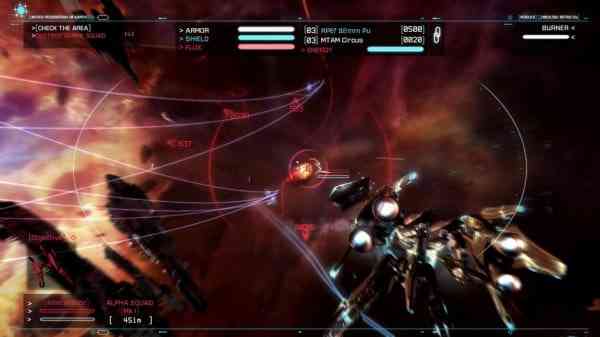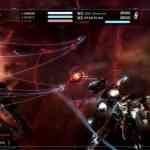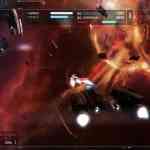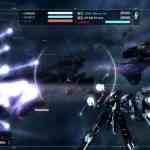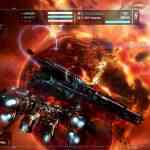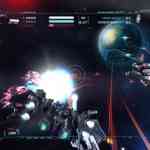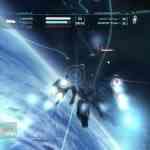What do you get when you take one part space combat sim and one part Japanese giant robot battle, stir in music from an award winning composer, sprinkle in 2012 success story Kickstarter, and ask UK developer Born Ready Games to put it all together? Well, you get Strike Suit Zero. For the past week I’ve been blasting my way through hoards of enemy spacecraft in this PC shooter. Does Strike Suit Zero deserve a place in your heart, or should you activate your boosters and pass it by?
Set in the year 2299, Strike Suit Zero is intriguing in premise. After the discovery of incredible technology allowed the people of earth to colonize the galaxy, the colonies wanted to take control of their own destiny and self govern. As has occurred many times during our history, a war broke out. The earth is threatened with destruction and only you stand in the way of this happening. Yes, the story is essentially off the shelf, and unfortunately it does a poor job of keeping you engaged. I never felt connected to the characters in the game and often struggled to remember who was who. The game teases with interesting technology; I found myself wanting to know more about the folding (hyperspace) tech and the human-AI hybrid in the game, but sadly these threads are largely left hanging. I would have liked to see these ideas fleshed out a little more within the story or through Mass Effect style data logs.
Fortunately, Strike Suit Zero’s gameplay is competent. During missions there are two main modes of play, the first of which is ship to ship dogfighting. In this mode everything is very responsive while still managing to lend a feeling of weight. Boosting, braking, and outturning your target works very well and generally compares to games like Ace Combat. Things really get crazy when the Strike Suit first appears. Any semblance of precision flight goes right out the window and your ship transforms into a boost dashing flying robot capable of firing hundreds of missiles at a time. The Suit can easily clear an area of enemies and makes insane odds feel manageable because of the massive amounts of damage it can deal in a short amount of time.
To keep everything balanced, the Strike Suit uses energy called Flux that you build up by killing enemies. This adds a welcome element of strategy without resorting to the resource management and energy transfer portions of true simulations. In practice, success requires quick switching from Strike mode to flight mode; raining destruction on a group of foes and then transforming and boosting to safety. Sadly there are many missions where the Strike Suit is not used, and these tend to feel like more of a chore.
While the flight and robot gameplay mechanics are quite good, the radar and mission objective system is baffling. The HUD shows the current mission objectives and highlights them when they are within view/range, but things get very confusing. All enemy ships and mission objectives show up as red arrows around the target reticule. Unfortunately, there are often way too many hostile ships on screen for the system to functionally handle. Blue arrows represent friendly targets, but it is frequently unclear what you are supposed to be doing. I found that you often end up with is a mass of blue and red arrows in your face, and it becomes almost impossible to distinguish what you should be focused on. For example, one mission asks you to protect a group of bombers and destroy some large enemy ships. Leaving the bombers alone for any amount of time results in their destruction, and the winning strategy is to exclusively protect them as doing so for long enough somehow destroys the enemy targets (when they still their shields up ironically).
The issue with the HUD System and unclear objectives is further confused by the targeting system. You can choose to target an enemy directly in front of you or the nearest target, but this is inconsistent. At times I had to continuously press the nearest target button, hoping to eventually be pointed towards the main objective. It took a number of failed missions for me to discover that the game likes to target non-essential things and ultimately punish you with mission failure.
Getting destroyed isn’t problematic; it’s the checkpoint system that really hurts. Checkpoints can be VERY far apart, in the range of 15-20 minutes of lost progress for beginners, and it doesn’t take too long when retracing your steps that this can become painful. Speaking of painful, Strike Suit Zero’s friendly AI tends to ignore current situations. They have their tasks and perform them reasonably, but they refuse to deviate from their one specific program. Often, they are focused on attacking enemy fighters. Even if the friendly command ship is on the verge of destruction, they refuse to help out. So be forewarned, if enemies overwhelm you in any way, you are on your own.
The game spans 13 missions, some of which are quite long, and depending on how often you die the campaign should last 6-8 hours. Regrettably, the missions definitely start to feel repetitive. Every mission is some combination of attacking a hostile target and defending a friendly target, and most engagements would be hard to tell apart if not for the visual flair Strike Suit Zero possesses. There is some replay incentive, with a medal system based on your mission score, and sometimes you’ll be rewarded for doing well with a new or upgraded weapon for your ship. The game doesn’t really embrace this mechanic though, as you only find out your score post mission, and the scores/objectives required for various medal levels aren’t listed in the mission briefing; thus any rewards felt totally random when I received them, and I didn’t feel the urge to best my previous scores.
Thankfully, Strike Suit Zero looks and sounds great. The ships in the game were designed by Junji Okubo, a respected Japanese mech designer who previously worked on Steel Battalion (Xbox) and Infinite Space (DS). His work definitely shines. The Strike Suit looks particularly excellent, and the larger cruisers impress in scope and design. Developer Born Ready did a really nice job filling out the world around the ships. The backgrounds are static but of very high quality and the variety of locales are about as wide as one can reasonably expect in a space combat game. The game pushes a lot of particles and objects at once too, and you’ll frequently see striking numbers of ships onscreen, all blasting each other at high speed. Explosions look convincing, swarms of missiles leave extravagant trails behind them, and there is a unique artifact effect presented when you are attacked that I especially liked. On both technical and artistic levels, Strike Suit Zero is a visual success.
In regards to the game’s audio, the music is similarly strong, composed by Paul Ruskay. It has a Middle Eastern flavour, and becomes suitably epic during intense firefights. The soundtrack also incorporates Japanese pop star Kokia in many places, which lends a unique dichotomy to the music as a whole. I did find the voice acting is very stiff though. Compared to voice acting standouts like Borderlands 2 and Mass Effect the characters feel largely emotionless, and sadly it negatively impacts the game en masse.
Strike Suit Zero is a game that comes close to greatness but still falls short. It looks and sounds the part with excellent visuals and a stirring soundtrack, and has competent gameplay mechanics, but it misses the mark with repetitive missions, a poorly developed story, and a fair bit of roughness around the edges. Strike Suit Zero is still worth a shot for fans space combat games or mech robots, but the uninitiated may find themselves disappointed with what Born Ready has come up with.


